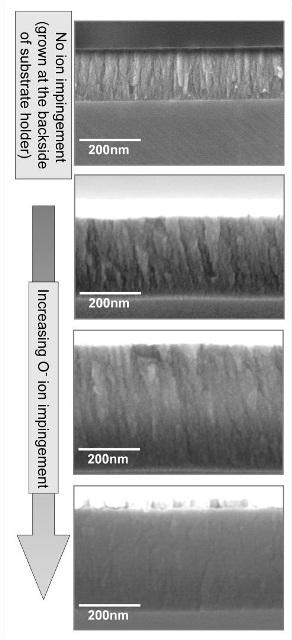A major concern in material science and technology is an understanding of the fundamental processes involved in thin film nanostructuration. Hence, plasma-assisted thin film deposition is applicable, especially because of the strong interaction between the film at the time of growth and the plasma-generated species, which may result in metastable structure formation that optimize or provide singular properties for a range of applications.
The PLASMATER (P10-FQM-6900) Project
The Junta de Andalucía-funded PLASMATER (P10-FQM-6900) project focuses on the analysis of these basic processes and their impact on the film nanostructure. For this purpose, it is required to combine film characterization techniques such as scanning electron microscopy, optical response measurements and atomic force microscopy with plasma diagnosis techniques, such as optical emission spectroscopy, mass spectrometry or Langmuir probe measurements.
Experimental Procedure and Results
The team used an energy-resolved mass spectrometer (EQP 500 HIDEN Analytical Ltd.) for gaining insight into the role of ion impingement on the growth of SiO2 thin films, which are deposited using DC pulsed magnetron sputtering.
DC pulsed magnetron sputtering discharges involve the generation of positively charged ions in the plasma bulk, and accelerate towards the film with kinetic energies of only a few electronvolts when the substrate is unbiased.
Even though, they may play a relevant role in thin film nanostructuration in certain cases, their typical energy is related to the displacement energy threshold of the material’s adatoms and they may in all likelihood, heat the film surface and induce thermally activated relaxation processes in a weak manner.
However, negative ions, present when an electronegative gas is introduced in the reactor, may be generated at the surface of the cathode and accelerated towards the film with energies of the order of the cathode potential fall (i.e., few hundred electronvolts).
These ions have sufficient energy to induce film adatom mobilization, through collisions, and cause significant changes in the nanostructure of the film. Even though, from an energetic point of view, negative ions are relevant, it was never very clear whether the flux was high enough to practically produce changes in the film until this research was conducted.
This study shows that microstructural changes on magnetron-sputtered SiO2 thin films occur due to negative oxygen ions. For this purpose, several coatings were deposited under carefully selected conditions with different microstructures.
After analyzing the role of relevant processes that impact film growth, such as surface shadowing, thermally activated processes on the surface and negative and positive ion impingement, it is concluded that the microstructural changes can be attributed to the impingement of intermediate energy O- ions.
These ions are seen in the discharge as a dissociation product of high-energy molecular oxygen negative ions generated near the cathode surface and accelerated towards the plasma. In Figure 1, four cross-sectional scanning microscopy images of films deposited for increasing O- ion flux bombardment are shown. The removal of vertical geometrical patterns and the void percentage for improving negative oxygen fluxes can be clearly observed.

Figure 1. Cross-sectional electron microscopy images of the films for increasing O- flux.
Conclusion
The presence of two thin film nanstructuration regimes at low temperatures, controlled by the oxygen quantity in the deposition reactor occurred due to the competition between the negative ion-induced adatom surface mobility process and the surface shadowing mechanism, has been shown in this study.

This information has been sourced, reviewed and adapted from materials provided by Hiden Analytical.
For more information on this source, please visit Hiden Analytical.